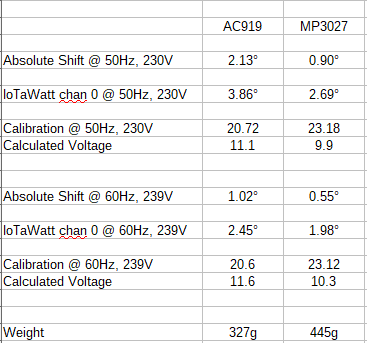As everyone down-under knows, I don’t offer a VT for Australia, and users are pretty much on their own. Fortunately, there seem top be two generally available 9VAC wall transformers. While users could easily calibrate the voltage, phase shift was unknown. Thanks to @KentW, I now have a sample of each and was able to measure the shift and generate table entries.
The two models are:
DCSS AC910. As I understand it this model was acquired from Radio Parts.
Powertech MP-3027. I understand this to have been sourced from jaycar.
First impressions are that the MP-3027 is heavier at 455g vs 327g for the AC910. My experience is that phase shift is inversely proportional to weight. The next significant observation is that the MP-3027 is efficiency level V while the AC910 is level IV.
Here are the numbers:

Absolute Shift - The shift of the direct transformer output vs the (more or less) pure sine wave of the line voltage.
IoTaWatt chan 0 - the shift as read by the IoTaWatt channel 0. This includes the shift of a 10uf capacitor in series with the voltage divider. At 50Hz, that’s about 1.75° and at 60Hz it’s about 1.43°.
So as foretold by the weight, the MP3027 has significantly lower shift than the AC919, but both are in a good working range. I have added both to the table file for next release, but anyone is free to download this table file tables.txt (2.5 KB) and replace your current table.
The table specifies both the 60Hz and 50Hz corrections, but IoTaWatt will use the 60Hz correction. The reason is that IoTaWatt also uses 60Hz corrections for the CTs, and the variation due to line frequency is similar making the match up better using the 60Hz numbers all around. Correction uses the net difference between the CT and VT. If you are using mostly solid-core CTs, it may be better to use the lower 50Hz phase correction, but with the ubiquitous SCT013, the difference is about +1° while the AC919 is about +1.4° and the MP3027 at about +0.7°. So less than +/- 0.5° is pretty good, especially considering that the CT shift varies over a range anyway.
I’d give the MP3027 four stars and the AC919 three.
When the new calibration rig is completed, there will be 50Hz values for the CTs as well, and I’ll change IoTaWatt to use the “P50” values when line frequency dictates.